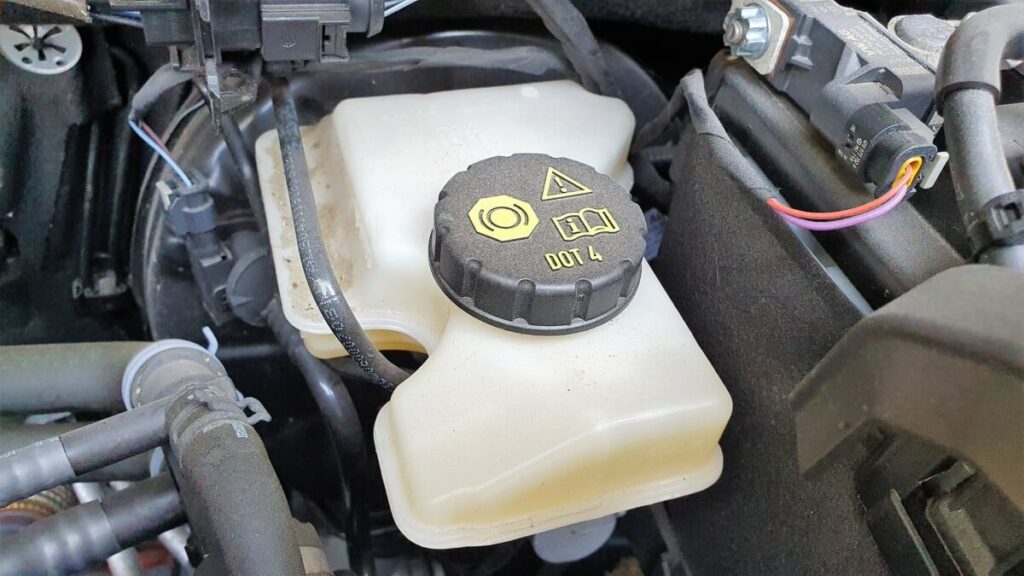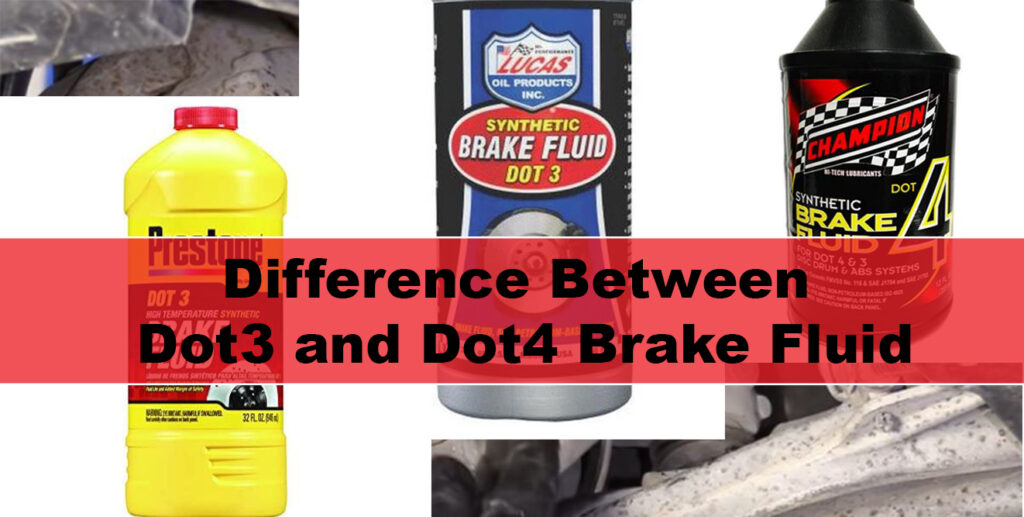Brake fluid is like the lifeblood of your car’s braking system. It’s a special liquid that helps transfer the force from your foot pressing the brake pedal to the actual brakes themselves. When you step on the brake pedal, the brake fluid gets pressurized and sends that pressure to the brake calipers or wheel cylinders, which then squeeze the brake pads or shoes against the rotors or drums, slowing down or stopping your wheels from spinning. It’s super important to have the right type of brake fluid and keep it in good condition, so your brakes work properly. DOT3 and DOT4 are specifications for brake fluid, which is a hydraulic fluid used in automotive braking systems. Both DOT3 and DOT4 brake fluids have different characteristics and are designed for specific applications.
DOT3 Brake Fluid:
DOT3 brake fluid is one of the most common types of brake fluid used in vehicles. It is a glycol-based fluid that has a lower boiling point compared to DOT4. The minimum dry boiling point for DOT3 is 205 degrees Celsius (401 degrees Fahrenheit), and the minimum wet boiling point is 140 degrees Celsius (284 degrees Fahrenheit).
DOT3 brake fluid is suitable for most everyday driving conditions and is commonly used in passenger cars, light trucks, and motorcycles. However, it is hygroscopic, meaning it absorbs moisture from the atmosphere over time. This can lead to a decrease in its boiling point and potentially affect brake system performance. Therefore, it is recommended to replace DOT3 brake fluid every two to three years.
What is DOT 3 brake fluid used for?
DOT 3 brake fluid is used in everyday passenger cars, light trucks, and motorcycles. Some specific applications include:
- Commuter Vehicles: DOT 3 brake fluid is suitable for everyday commuting vehicles such as sedans, hatchbacks, and compact cars. It provides adequate braking performance for regular city driving and highway cruising.
- Family Vehicles: Minivans, SUVs, and family-oriented vehicles often use DOT 3 brake fluid. These vehicles typically carry passengers and cargo, and DOT 3 brake fluid offers sufficient braking power for their average loads.
- Light Trucks: DOT 3 brake fluid is also used in light trucks, including pickup trucks and small commercial vehicles. It meets the braking requirements for these vehicles’ weight capacities and regular driving conditions.
- Motorcycles: Many motorcycles, especially those intended for street use, use DOT 3 brake fluid in their hydraulic braking systems. It offers reliable stopping power for motorcycles operating within standard riding conditions.
DOT 3 brake fluid is suitable for regular driving, it has a lower boiling point compared to DOT 4 brake fluid. This makes it less suitable for high-performance or heavy-duty vehicles that may generate greater braking heat or experience more demanding braking situations.
DOT4 Brake Fluid:
DOT4 brake fluid is also a glycol-based fluid but has a higher boiling point compared to DOT3. The minimum dry boiling point for DOT4 is 230 degrees Celsius (446 degrees Fahrenheit), and the minimum wet boiling point is 155 degrees Celsius (311 degrees Fahrenheit).
DOT4 brake fluid provides better performance under high-temperature conditions and is often used in vehicles that undergo more demanding braking situations, such as heavy-duty trucks, high-performance vehicles, and racing cars. It is less hygroscopic than DOT3 brake fluid, which means it absorbs moisture at a slower rate. However, it still requires periodic replacement to maintain optimal performance.
Note: DOT3 and DOT4 brake fluids are not compatible, and they should not be mixed in the same brake system. Always follow the vehicle manufacturer’s recommendations and use the specified brake fluid for your car. You can find the appropriate brake fluid specification in the vehicle’s owner’s manual or on the brake fluid reservoir cap.
What is DOT 4 Brake Fluid Used For?
DOT 4 brake fluid is used in vehicles that require higher-performance braking capabilities or operate under more demanding conditions. Some common applications are listed below:
- High-Performance Vehicles: DOT 4 brake fluid is often found in high-performance cars, sports cars, and racing vehicles. These vehicles require brake fluids that can handle the increased heat generated during aggressive driving and repeated high-speed braking. DOT 4 brake fluid’s higher boiling point helps maintain consistent braking performance under these demanding conditions.
- Heavy-Duty Trucks: DOT 4 brake fluid is suitable for heavy-duty trucks and commercial vehicles that carry heavier loads. These vehicles may experience increased brake temperatures due to their weight, frequent braking, or towing capacity. DOT 4 brake fluid’s higher boiling point provides better resistance to fluid boil-off and helps prevent brake fade.
- Performance Upgrades: If you have made performance upgrades to your braking system, such as installing larger calipers or upgrading brake pads, using DOT 4 brake fluid is often recommended. The increased braking power and heat generated by these upgrades can be better managed by DOT 4 fluid.
- Extreme Conditions: Vehicles operating in extreme environments, such as off-road vehicles or those used in hot climates, can benefit from the higher boiling point and improved performance of DOT 4 brake fluid.
What is the Difference Between Dot 3 and Dot 4 Brake Fluid?

Alright, let’s break it down! DOT3 and DOT4 are different specifications of the fluid used for the same reason, and they have a few key differences:
- Boiling Point: DOT3 has a lower boiling point compared to DOT4. The minimum dry boiling point for DOT3 is around 205 degrees Celsius (401 degrees Fahrenheit), while DOT4 has a higher minimum dry boiling point of about 230 degrees Celsius (446 degrees Fahrenheit). This means that DOT4 can withstand higher temperatures without boiling, which is important for performance in demanding conditions.
- Hygroscopicity: Both DOT3 and DOT4 brake fluids are hygroscopic, which means they absorb moisture from the air over time. However, DOT4 is less hygroscopic compared to DOT3. This means that DOT4 absorbs moisture at a slower rate, which helps maintain its performance over a longer period.
- Applications: DOT3 brake fluid is commonly used in everyday driving situations. It’s found in most passenger cars, light trucks, and motorcycles. On the other hand, DOT4 brake fluid is often used in vehicles that experience more demanding braking conditions, such as heavy-duty trucks, high-performance cars, and racing vehicles.
Is it OK to use DOT4 brake fluid in a DOT 3 car?
Using DOT4 fluid in a vehicle that requires DOT3 is generally acceptable and safe. DOT4 brake fluid has a higher boiling point and better performance characteristics than DOT3, which can be beneficial for certain driving conditions or vehicles that experience more demanding braking situations.
However, it is important to note that once you switch to DOT4 brake fluid, you should continue using DOT4 and not revert back to DOT3. This is because DOT4 is less hygroscopic, meaning it absorbs moisture at a slower rate, while DOT3 is more hygroscopic. Mixing different types of brake fluid can lead to a decrease in performance and potentially affect the braking system’s overall effectiveness.
If you decide to switch to DOT4 brake fluid, it’s a good practice to thoroughly flush and replace all the old DOT3 brake fluid from the system to ensure a complete transition. This helps minimize any potential mixing of the two fluids and ensures optimal performance.
What vehicles use DOT 4 brake fluid?
DOT 4 brake fluid is commonly used in vehicles that require a higher-performance brake fluid. You’ll find it in a variety of vehicles, such as heavy-duty trucks, high-performance cars, sports cars, and even some motorcycles. These vehicles often put more stress on the braking system due to their weight, power, or demanding driving conditions. So, DOT 4 brake fluid helps them maintain better braking performance under high temperatures and more intense use.
What vehicles use DOT 3 brake fluid?
DOT 3 brake fluid is usually used in everyday passenger cars, light trucks, and motorcycles. It’s the go-to brake fluid for most regular driving conditions. So, if you’re driving your trusty sedan, compact car, family SUV, or even a standard motorcycle, chances are it’s running on DOT 3 brake fluid. It provides reliable braking performance and meets the requirements of most typical driving situations. Just remember to follow the manufacturer’s recommendations and replace it every couple of years to ensure optimal performance and safety on the road.
What happens if you use wrong brake fluid?

Using the wrong brake fluid in your vehicle can have several potential consequences. Different brake fluids have different formulations and properties. Using the wrong brake fluid can compromise the hydraulic system’s performance, resulting in reduced braking effectiveness. Your brakes may feel spongy, less responsive, or have an overall decreased stopping power.
Brake fluids have specific chemical compositions designed to work with the materials and seals in your vehicle’s braking system. Using the wrong brake fluid can cause damage to these components over time. For example, incompatible brake fluid can cause rubber seals to deteriorate or swell, leading to leaks and potential brake failure.
It also has a specific boiling point, and using a lower-grade brake fluid in a high-performance braking system can lead to fluid boiling under extreme heat generated during aggressive driving or heavy braking. Boiling brake fluid can create vapor bubbles in the system, resulting in a loss of hydraulic pressure and reduced braking performance. This phenomenon is known as vapor lock.
Because of the different chemical compositions, the wrong brake fluid can lead to corrosion and contamination of the brake system. This can result in damage to brake lines, cylinders, calipers, and other components, potentially leading to leaks and brake failure.
Frequently Asked Questions:
What is brake fluid, and why is it important in a car’s braking system?
Brake fluid is a hydraulic fluid that plays a crucial role in transmitting force from the brake pedal to the brake components, allowing your car to stop safely. It is essential for maintaining the performance and safety of your vehicle’s braking system.
What are DOT3 and DOT4 brake fluids, and how do they differ?
DOT3 and DOT4 are two different specifications or types of brake fluid. They differ primarily in their boiling points and compatibility with various brake systems. DOT4 brake fluid has a higher boiling point and is often considered an upgrade from DOT3.
What is the significance of the boiling point in brake fluid?
The boiling point of brake fluid is crucial because it indicates the fluid’s ability to withstand high temperatures without boiling or forming gas bubbles. Brake fluid boiling can lead to brake fade, reduced braking performance, and safety risks.
What is the boiling point of DOT3 brake fluid?
DOT3 brake fluid typically has a dry boiling point (unexposed to moisture) of around 401°F (205°C) and a wet boiling point (exposed to moisture) of approximately 284°F (140°C).
What is the boiling point of DOT4 brake fluid?
DOT4 brake fluid generally has a higher boiling point than DOT3. It typically has a dry boiling point of around 446°F (230°C) and a wet boiling point of approximately 311°F (155°C).
Final Remark
Make sure to check into your manual before purchasing a fluid so there will never be any transmission related problems. Wrong fluid can damage internal components of the car, which besides decreasing the value, in case you decide to sell it, puts YOU in danger.



